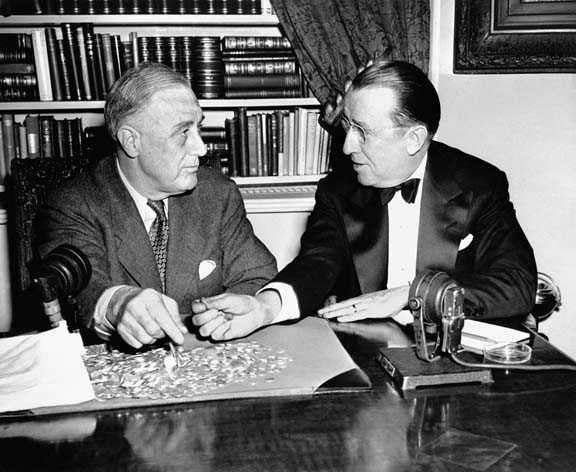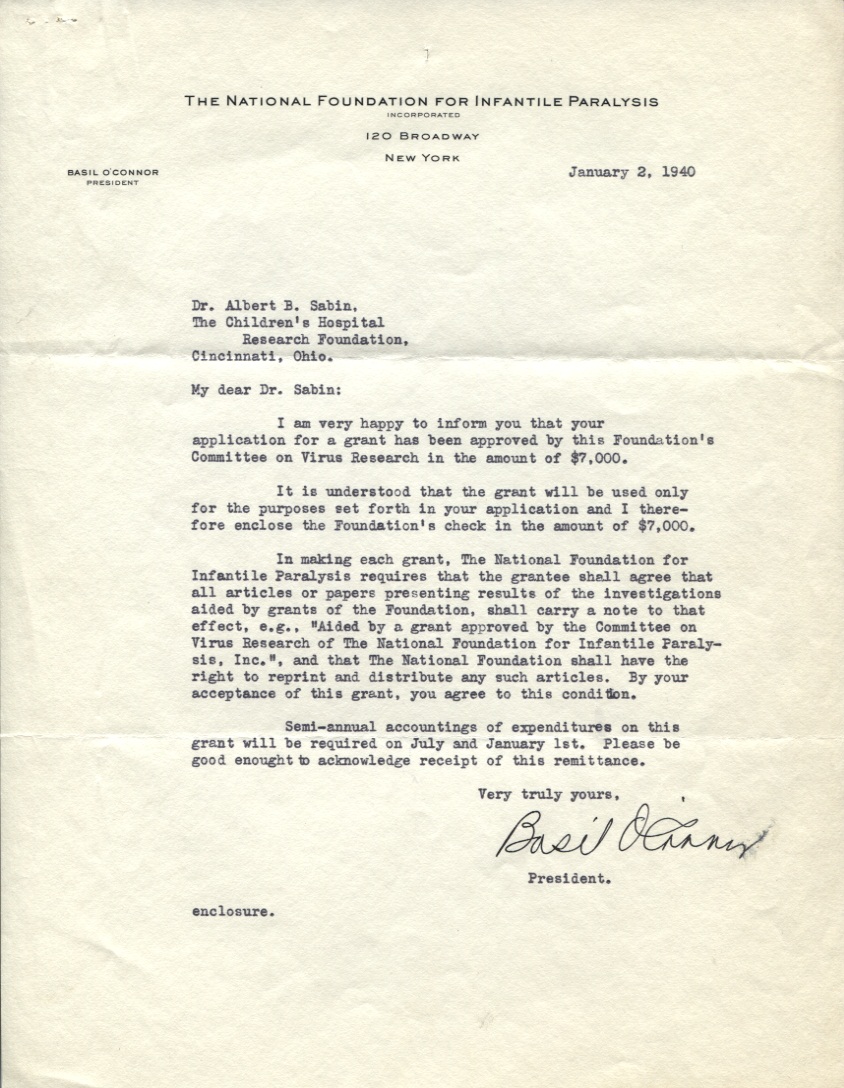The National Foundation for Infantile Paralysis (now known as the March of Dimes) played an important role in the research and development of Dr. Sabin’s oral polio vaccine. According to the March of Dimes, Dr. Sabin received around $1.5 million to support his research on polio from 1952 to 1961. Our collection has a couple of boxes labeled “NFIP,” as well as letters scattered throughout the collection from notables such as Basil O’Connor, Donald W. Gudakunst, and Thomas Rivers. I thought I’d share a little about the NFIP and some material we have.

Photograph of President Franklin Roosevelt and Mr. Basil O’Connor, 1944. Courtesy of the March of Dimes.
Founded in 1938 by President Franklin D. Roosevelt, the National Foundation for Infantile Paralysis’s mission was to “‘lead, direct, and unify’ the fight against polio, a paralyzing viral disease.” The leader of this organization was Basil O’Connor, who was president for over 30 years. (Both of these men can be seen in the photo to the right.) The NFIP was created to raise funds for poliomyelitis research for every stage of the disease, unlike the Georgia Warm Springs Foundation (also founded by Roosevelt), which worked to improve the quality of life of those who had already been affected by polio. One of the major NFIP fundraisers was the “March of Dimes,” which urged all people to send at least a dime to support President Roosevelt in the fight against polio. Researchers such as Dr. Sabin and Dr. Jonas Salk benefited from fundraising efforts such as this because of the grant money they received from the NFIP. Over the years since the NFIP was founded, its name has changed to the March of Dimes, and its mission has evolved to improve the health of babies by preventing birth defects, premature birth, and infant mortality. (See the History of the March of Dimes for more information.)
Looking back to October 1939, Dr. Sabin wrote a letter to the NFIP requesting an application for funds for poliomyelitis research. The letters that followed showed a couple of interesting exchanges between him and the NFIP. First was a letter from Basil O’Connor himself, letting Dr. Sabin know that his letter was forwarded to Dr. Paul de Kruif (author of Microbe Hunters, briefly mentioned in last week’s blog). Dr. Sabin replied back to Mr. O’Connor, “When I sent my letter to the National Foundation, I did not suspect that it would reach your attention, or else I would have taken the opportunity to address you personally.” Honestly, it also caught me by surprise that Mr. O’Connor personally responded to Dr. Sabin’s request for an application!
An exchange between Dr. de Kruif and Dr. Sabin was also interesting to me. After Dr. Sabin submitted his application, Dr. de Kruif wrote to him, “I received your application with considerable surprise because your recent paper on the joint-infection matter led me to think that you had abandoned polio research.” Dr. Sabin replied, “[…] I can only say that that was not my intention and that the facilities of my present position are such that I can pursue studies in more than one field either simultaneously or at different times of the year depending in part upon the type of clinical material that is available.” Dr. de Kruif quickly replied, “Do pardon me if — which was not my intention— I said anything to miff you! The impression that was conveyed to me was that your observations on the rheumatic condition in mice had led you to abandon your intention to work with the Foundation on the nature of the virus.” Could you imagine if Dr. Sabin would have decided to focus on “the rheumatic condition” rather than on polio?
In January 1940, Dr. Sabin received a letter from Mr. O’Connor granting him $7000 from the NFIP for his research. By August of that year, Dr. Sabin requested an additional $2000 to cover the cost of monkeys needed for research. This was just the beginning of a long relationship between the NFIP and Dr. Sabin. I plan to chronicle more of this relationship as we continue the digitization project.
Notes: First, I want to thank David Rose, archivist for the March of Dimes, for providing me with background information on the organization. The March of Dimes Archives contains a wealth of information on the subject of polio and its vaccines, including vaccine records from both Drs. Sabin and Salk. Second, the letters quoted in this post can be found in Series #10 – Professional Affiliations and Memberships, Box #6 – NFIP Research, Folder #1 – “1939-1943, Applications, Reports, Correspondence.”
In 2010, the University of Cincinnati Libraries received a $314,258 grant from the National Endowment for the Humanities (NEH) to digitize the correspondence and photographs of Dr. Albert B. Sabin. This digitization project has been designated a NEH “We the People” project, an initiative to encourage and strengthen the teaching, study, and understanding of American history and culture through the support of projects that explore significant events and themes in our nation’s history and culture and that advance knowledge of the principles that define America. Any views, findings, conclusions, or recommendations expressed in this blog do not necessarily reflect those of the National Endowment for the Humanities.

